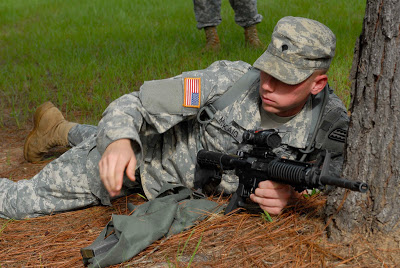
Testing the new version of the M-8 bandoleer at Fort Benning.
Read this from Army.Mil News, and then we'll chat.
Fort Benning tests new M-8 bandoleer
Aug 27, 2009
By Vince Little, The Bayonet
FORT BENNING, Ga. (Aug. 28, 2009) -- Soldiers from the Maneuver Battle Lab's experimentation force tossed around the current M-8 bandoleer and a candidate replacement version during a weeklong assessment on Fort Benning.
Eighteen members of A Company, 1st Battalion, 29th Infantry Regiment took part in the strength and dependability tests, which included a look at how easily they could access the clipped 5.56mm ammunition from the bags. The evaluation was held Aug. 17-21 at the McKenna Urban Operations Complex.
The M-8 bandoleer is a bag with small pockets for storing cartridges and magazines, worn over the shoulder and across the chest.
Lisa Aversa, a packaging engineer from Picatinny Arsenal in New Jersey who observed the limited objective experiment, said the bandoleer now in use by the Army and Marine Corps is oblong-shaped with four pockets and made of cotton or a cotton-polyester blend. The potential replacement is all polyester, features two pockets and is produced through ultrasonic welding, which makes it more compact. Both bags hold 120 rounds of ammo.
Early in the week, the Soldiers took both bandoleers on McKenna's individual movement technique, or IMT, obstacle course. Evaluators also measured how far the Soldiers could throw the bags.
They resupplied each other during mock daytime and nighttime raids on a building and house, tossing the bandoleers through a second-floor window. In a separate scenario, they distributed ammunition along the perimeter of a "patrol base" under attack.
Large containers with fully packed bandoleers for U.S. troops have been dropped on battlefields for more than 50 years, said Niral Patel, a packaging engineer from Picatinny Arsenal.
"The ammo can be distributed quicker or carried quicker," he said. "You can throw it over your shoulder and go."
But many Soldiers from the experimentation force said the present bandoleer was sturdier than the candidate replacement version. Some also said they'd rather use other ammo-dispersal methods in combat.
"The material on the new one is brittle. It's not as tough as the old one," said Spc. James Mocello. "When the new ones get tension on them, they just break off."
Sgt. William MacMillan said the candidate bandoleers "tear pretty easily" on the obstacle course and while throwing them around to other Soldiers. He fears "bandoleers would be (strewn) all over the place" in a firefight.
"We found better ways to distribute ammunition - especially in combat," MacMillan said. "Any time we need to refit each other, I never have used bandoleers. We normally use a rucksack or backpack because you can carry more ammo, and it's easier to distribute.
"If I had to pick, the old (bandoleer) works better. But if there needed to be a change, I don't think it matters, because we really don't use them anyway."
Soldiers aren't being told to choose the bandoleer over a backpack or rucksack, Patel said. But he said he thinks the candidate replacement version is a better option than the current bag because the new design uses less material, which makes it easier to unload and repack small-caliber ammunition.
"Any candidate bandoleer should be as good as or better than the current one," said Jonathan Porter, a project officer for the Maneuver Battle Lab's futures branch. "Even though Soldiers might not use it all the time, it should provide equal or better capabilities. Our main objective was to assess the durability and reliability between the two to get a comparison."
Aversa said cost savings in manufacturing the candidate M-8 bandoleer could be significant because polyester is less expensive than cotton per square foot.
"We'll be looking at things we could maybe tweak in the design," she said.
Officials said any prototype changes would be based on the Maneuver Battle Lab's final report, which is due Oct. 2. An integrated product team will ultimately decide whether the current bandoleer is replaced.
OK, meet the M-4 bandoleer as issued in Vietnam.
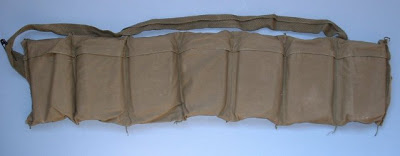
(Previous bandoleers were denoted the M-1, for Garand and Carbine ammunition, and the M-2, for M-14 ammunition.)
You will note that the M-4 has seven pockets, each containing twenty rounds of stripper-clipped 5.56mm ammo (ten rounds to the stripper, held in cardboard spacers, 2 clips to each spacer and one spacer to each pocket).
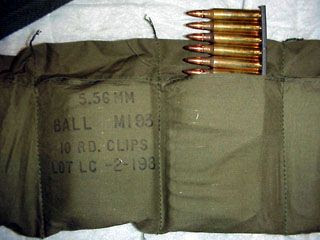
When issued for the field, GIs and Marines would take the strippers and the stripper clip guide that came with each bandoleer, load up their twenty round magazines and put the loaded mags back in the bandoleer, as here:

And here:
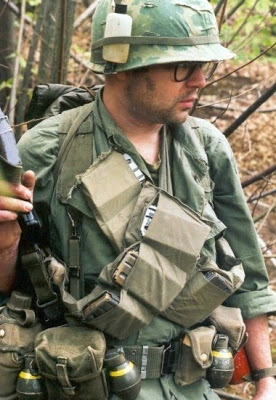
When the Army went from the twenty round magazine to the thirty rounder, it did not immediately change the bandoleer.
This was the cause of great frustration on the part of light infantrymen, who recognized the utility of using the bandoleer to carry loaded magazines in addition to what was in their LBE mag pouches. Thus was born the four pocket M-8 bandoleer:
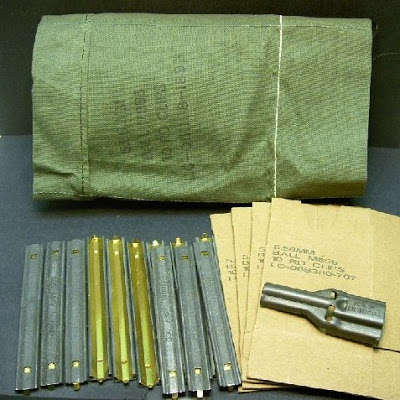 The components of the M-8 bandoleer system, sans ammunition.
The components of the M-8 bandoleer system, sans ammunition.This bandoleer holds 120 rounds of 5.56 in 10 round stripper clips, thirty rounds per pocket. Note the white string running through the bandoleer about two-thirds of the way toward the bottom. With this system, you get your ammo from the can, strip it into your mags and then pull the string out, which lengthens the pocket and thus you now have room to accommodate loaded thirty rounders.
Now, let us return to the story above.
They resupplied each other during mock daytime and nighttime raids on a building and house, tossing the bandoleers through a second-floor window. In a separate scenario, they distributed ammunition along the perimeter of a "patrol base" under attack.
Large containers with fully packed bandoleers for U.S. troops have been dropped on battlefields for more than 50 years, said Niral Patel, a packaging engineer from Picatinny Arsenal.
"The ammo can be distributed quicker or carried quicker," he said. "You can throw it over your shoulder and go."
This is the utility of a bandoleer, particularly being able to toss it to a buddy who is in a better position to engage the enemy, and even more particularly across a danger space under enemy observation and fire.
But many Soldiers from the experimentation force said the present bandoleer was sturdier than the candidate replacement version. Some also said they'd rather use other ammo-dispersal methods in combat.
"The material on the new one is brittle. It's not as tough as the old one," said Spc. James Mocello. "When the new ones get tension on them, they just break off."
Sgt. William MacMillan said the candidate bandoleers "tear pretty easily" on the obstacle course and while throwing them around to other Soldiers. He fears "bandoleers would be (strewn) all over the place" in a firefight.
"We found better ways to distribute ammunition - especially in combat," MacMillan said. "Any time we need to refit each other, I never have used bandoleers. We normally use a rucksack or backpack because you can carry more ammo, and it's easier to distribute.
"If I had to pick, the old (bandoleer) works better. But if there needed to be a change, I don't think it matters, because we really don't use them anyway."
In Iraq and Afghanistan the US Army and US Marines are at the tail end of logistics wonder. Most often their ammo comes to the rifleman already pre-loaded in magazines by their supply echelon. Why not? The government has an immense number of 30 round rifle magazines, and an extraordinary number of supply Fobbits to load them.
Yet while SGT MacMillan is correct that there are better ways of distributing ammunition IF YOU HAVE THE RESOURCES AND TIME, the fact is that ammunition still must be produced and stored with an eye to long-term storage and then, instant use when needed. You cannot store rounds in loaded magazines. Not even the government has that much money. Thus, the bandoleer, stripper clip system continues to serve and will contine to serve, I suppose, until we get phaser rifles.
Yet the M-8 system has its inadequacies: the cloth is too flimsy. While light and thin (an advantage in getting thge maximum number of rounds per can), the material is too light to protect a loaded magazine. I own a four-pocket bandoleer for my China Doll (Polytech M14S) patterned on the M-8 bandoleer but made of much stouter Woodland cloth that was made by the darling wife of my brother from another mother.
Some of you may remember this Oleg Volk image from Fight Light, and Win:
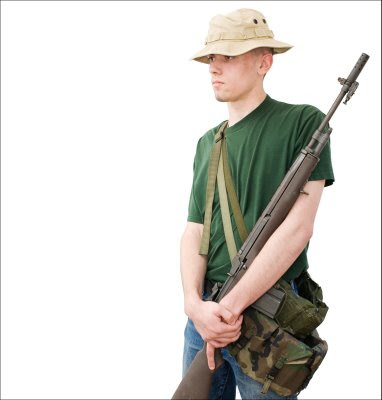
That's my China Doll with M14E2 muzzle brake and the aforesaid home-made magazine bandoleer, supplemented with a British bando stuffed with stripper-clipped 7.62 NATO (and stripper clip guide, of course, though you should always have an extra on your person).
So I do not dispute that going into action with loaded mags is far superior to ammo in stripper clips and bandoleers -- certainly not. What I AM saying is that, like the Army, I have yet to find a system for long-term storage of ammunition (Can you say, "cache"?) that will serve the need for distributing it quickly where it needs to be once opened and still enable the militiaman to get it rapidly into the weapon at the point of contact.
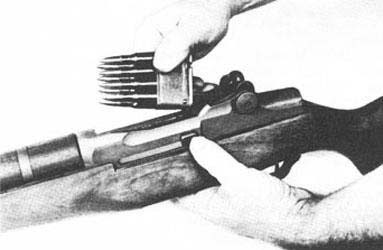
Of course, this goes double for those of you who have a top-loading semi-auto such as a Garand or an SKS. ALL of your ammo should be in clips and bandoleers. ALL of it.
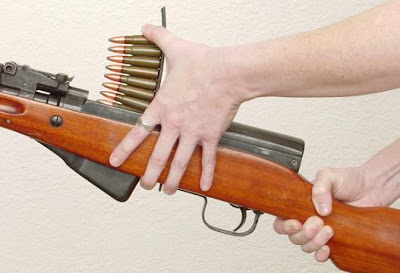
It is unfortunate that this new material does not seem to be working out. But you can count on one thing: until we have Captain Kirk's phaser rifles, we will be loading ammo from stripper clips and bandoleers into magazines.
Mike
III

10 comments:
Nice suggestion boss, but XXXXX rds of 7.62X39 economically speaking, does not go in bandoleers nor stripper clips easily. Rest assured, a substantial and varied amount does. The rest is reserve. I and mine use the combat vest to utililze the 30rd mags for the ARs, and leg pouches for the extra, with at least two mags in a small pack on the back for reserve/SHTF. Plus our SOP is to have a reserve man or two with a large ammo box full of loaded magazines no farther than 250 meters to the rear of our attack position, with orders to come forward on pre-arranged signals, or on radio or runner contact, or go elsewhere as needed. And of course per SOP, immediately after we take an objective, we redistribute ammo whilst preparing for a counter-attack, and movement to the next objective, or whatever is outlined in our operations order. It makes no difference, to me, what you carry ammo in, as long as it: is silent,fast,and works. But mostly we customize our stuff to do so.
So don't they still issue those nylon mag pouch bandoleers, something like this?:
https://www.mainemilitary.com/productcart/pc/viewPrd.asp?idcategory=108&idproduct=2379
Either way, I see these things cheap as hell all the time. I don't know about packaging but for carrying spare ammo in your rucksack they seem like the thing to have.
It looks like Vanderboegh totally ignores perhaps the most telling section of the article he posted, and then responded to in his typically lengthy fashion.
"We found better ways to distribute ammunition - especially in combat," MacMillan said. "Any time we need to refit each other, I never have used bandoleers. We normally use a rucksack or backpack because you can carry more ammo, and it's easier to distribute.
"If I had to pick, the old (bandoleer) works better. But if there needed to be a change, I don't think it matters, because we really don't use them anyway."
So right there, in the middle of the article about bandoleers is a Sgt saying that he's never used bandoleers, and the soldiers he knows don't use them, because rucksacks and backpacks are used instead.
But yet, we get another sermon about bandoleers...that totally ignores the current soldier saying that old style vs new style bandoleers doesn't matter, because they don't use them anyway, and prefer to carry larger quantities of ammo in rucks or packs.
Even with a phaser rifle, we'll probably still have something like it, at least for a while. It takes a LOT of either batteries or chemicals to make a decent laser/particle beam, and you'll have to have a way to carry them around.
We are approaching the point where you might start seeing energy weapons replacing light vehicle mounted guns--laser diodes and such are getting enough life in them to be practical, and on a vehicle, you need not worry about battery life as much.
Anon 12:38, having got up on the grumpy side of the bed this morning, sez:
"So right there, in the middle of the article about bandoleers is a Sgt saying that he's never used bandoleers, and the soldiers he knows don't use them, because rucksacks and backpacks are used instead.
But yet, we get another sermon about bandoleers...that totally ignores the current soldier saying that old style vs new style bandoleers doesn't matter, because they don't use them anyway, and prefer to carry larger quantities of ammo in rucks or packs."
Anon, I refer you to these two paragraphs:
"In Iraq and Afghanistan the US Army and US Marines are at the tail end of logistics wonder. Most often their ammo comes to the rifleman already pre-loaded in magazines by their supply echelon. Why not? The government has an immense number of 30 round rifle magazines, and an extraordinary number of supply Fobbits to load them.
Yet while SGT MacMillan is correct that there are better ways of distributing ammunition IF YOU HAVE THE RESOURCES AND TIME, the fact is that ammunition still must be produced and stored with an eye to long-term storage and then, instant use when needed. You cannot store rounds in loaded magazines. Not even the government has that much money. Thus, the bandoleer, stripper clip system continues to serve and will continue to serve, I suppose, until we get phaser rifles."
Now, the ammo that SGT MacMillan refers to, is, I am sure, not in stripper clips anymore but in loaded magazines. The ammo comes to them in cans/bandoleers and stripper clips and either the Fobbits or the troops themselves load the mags with it before the operation, or as part of the supply operation. Yet the militiaman, who does not have this massive support tail behind him nor the resources to buy an infinite supply of magazines, must set up his own supply with a forward-looking eye to ultimate use in a hurry.
Are you suggesting that SGT MacMillan is saying that he and his mates pack stripper clipped (ammo as it comes from the factory through the supply chain) or even loose ammo in those rucks? Surely you see he is referring to loaded magazines.
In any case, even if they are loose LOADED MAGS in the ruck, the utility of being able to toss a loaded bandoleer -- containing either stripper clips or magazines -- across a danger space is lost. Try tossing a loaded ruck sometime.
There are militiamen who do not have the resources to put all of their ammo in stripper clips and bandoleers. There are some who can't afford to put ANY of their ammo in stripper clips and bandoleers. I understand that. All I'm saying is that those who don't put as much of it as they can in that form, for whatever reason, will in the end wish they had. -- The Insufferable Vanderboegh.
While not really a bandoleers, I like these grab and go bags made by a retired Marine in Tuscaloosa, Alabama:
http://olongapooutfitters.com/
I've seen some of his work on various forums and have been impressed by the thought that goes into it. I will be ordering one of his shotgun bags soon.
Anonymnous 12:38 - ALL my ammo is on strippers in bandoleers in cans because that's the only way I'll ever be able to use it.
One point missed in the article: No soldier worth his salt would take mags loaded by REMFs and stake his life on it.
Every one I know cleans his own mags obsessively - unload, wipe off every round, disassemble mags, wipe off and closely inspect every round, then a final reload.
Much easier to do if the ammo comes on strippers so I can load my mags myself, thankyouverymuch.
Even the "backpack" isn't full of loose strippers - it's full of bandoleers or loaded mags...1
I was mulling the article you cited over and suddenly something occurred to me. They said the new experimental bandoleers they are testing are made of pure polyester? But pure polyester melts, and even worse, it drips. It can result in catastrophic burns while someone with the same exposure wearing cotton will barely be singed. NOT the material I would choose for combat gear, especially gear worn next to the body.
I'd thought of this for days, and came back to post it, only to find Mr. Gilson beat me to it.
Polyester?
I **LOVE** my underarmor, but after seeing the "after" pictures of some poor sap I'll never wear it again...
The only thing I'm going to say about all this Praxis crap, is that it doesn't matter to people in my situation, too old to carry, too sick to survive without medicine, too proud to surrender and too damn tough to take without paying a steep price.
I don't expect to survive the opening days, I do expect to give them something to think about when they have to try people 40 and 50 years younger than I. Because I seriously expect to teach them a lesson about freemen and their determination to die free. And I expect to teach them the cost of fucking with a man who will not submit.
I do not expect to be the hero who survives, I do hope to buy time for those who not only will survive but prevail. And give my grandchildren and great grandchildren the gift of freedom. I will buy you as much time as I can, but you must not waste it, for there will be many of us, but we are old and sick and halt and lame, our hearts are pure and we burn with a passion for liberty, but our bodies cannot sustain us through the long haul. We can die to give you a shot, and we will die at a price, you must not waste it if you are to prevail and our republic is to endure.
Post a Comment